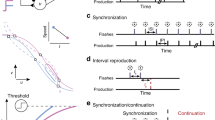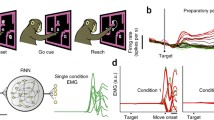Abstract
This article describes a neural network model, called the VITEWRITE model, for generating handwriting movements. The model consists of a sequential controller, or motor program, that interacts with a trajectory generator to move a hand with redundant degrees of freedom. The neural trajectory generator is the vector integration to endpoint (VITE) model for synchronous variable-speed control of multi-joint movements. VITE properties enable a simple control strategy to generate complex handwritten script if the hand model contains redundant degrees of freedom. The proposed controller launches transient directional commands to independent hand synergies at times when the hand begins to move, or when a velocity peak in a given synergy is achieved. The VITE model translates these temporally disjoint synergy commands into smooth curvilinear trajectories among temporally overlapping synergetic movements. The separate “score” of onset times used in most prior models is hereby replaced by a self-scaling activity-released “motor program” that uses few memory resources, enables each synergy to exhibit a unimodal velocity profile during any stroke, generates letters that are invariant under speed and size rescaling, and enables effortless connection of letter shapes into words. Speed and size rescaling are achieved by scalar GO and GRO signals that express computationally simple volitional commands. Psychophysical data concerning hand movements, such as the isochrony principle, asymmetric velocity profiles, and the two-thirds power law relating movement curvature and velocity arise as emergent properties of model interactions.
Similar content being viewed by others
References
Abend W, Bizzi E, Morasso P (1982) Human arm trajectory formation. Brain 105:331–348
Bradski G, Carpenter GA, Grossberg S (1992) Working memory networks for learning temporal order with application to 3-D visual object recognition. Neural Computation 4:270–286
Bullock D, Grossberg S (1988) Neural dynamics of planned arm movements: emergent invariants and speed-accuracy properties during trajectory formation. Psychol Rev 95:49–90
Bullock D, Grossberg S (1991) Adaptive neural networks for control of movement trajectories invariant under speed and force rescaling. Hum Mov Sci 10:3–53
Bullock D, Contreras-Vidal JL, Grossberg S (1992) Equilibria and dynamics of a neural network model for opponent muscle control. In: Bekey G, Goldberg K (eds) Neural networks in robotics. Kluwer Academic, Norwell, Mass, pp 439–457
Bullock D, Grossberg S, Guenther F (1993) A self-organizing neural model of motor equivalent reaching and tool use by a multijoint arm. J Cogn Neurosci (in press)
Carpenter GA, Grossberg S (1991) Pattern recognition by self-organizing neural networks MIT Press, Cambridge, Mass
Cohen M, Grossberg S (1986) Neural dynamics of speech and language coding: developmental programs, perceptual grouping, and competition for short term memory. Hum Neurobiol 5:1–22
Cohen M, Grossberg S (1987) Masking fields: a massively parallel neural architecture for learning, recognizing, and predicting multiple groupings of patterned data. Applied Optics 26:1866–1891
Dooijes EH (1983) Analysis of handwriting movements. Acta Psychol 54:99–114
Edelman S, Flash T (1987) A model of handwriting. Biol Cybern 57:25–36
Fetters L, Todd J (1987) Quantitative assessment of infant reaching movements. J Mot Behav 19:147–166
Fowler C (1980) Coarticulation and theories of extrinsic timing. J Phonetics 8:113–133
Gaudiano P, Grossberg S (1991) Vector associative maps: unsupervised real-time error-based learning and control of movement trajectories. Neural Networks 4:147–183
Georgopoulos AP, Kalaska JF, Caminiti R, Massey JT (1984) The representation of movement direction in the motor cortex: single cell and population studies. In: Edelman GM, Gall WE, Cowan WM (eds) Dynamic aspects of neocortical function. Wiley, New York, pp 501–524
Golani I (1992) A mobility gradient in the organization of vertebrate movement: the perception of movement through symbolic language. Behav Brain Sci 15:249–308
Greve D, Grossberg S, Guenther F, Bullock D (1992) Neural representations for sensory-motor control. I Head-centered 3-D target positions from opponent eye commands. Acta Psychol 82:115–138
Grossberg S (1982) Studies of mind and brain: neural principles of learning, perception, development, cognition and motor control. Reidel Press, Boston
Grossberg S, Guenther F, Bullock D, Greve D (1992) Neural representations for sensory-motor control. II Learning a head-centered visuomotor representation of 3-D target position. Neural Networks 6:43–67
Hollerbach JM, Moore SP, Atkeson CG (1986) Workspace effect in arm movement kinematics derived by joint interpolation. In: Gatchev G, Dimitrov B, Gatev P (eds) Motor control. Plenum Press, New York
Jeannerod M (1988) The neural and behavioral organization of goaldirected movements. Clarendon Press, Oxford
Lacquaniti F, Terzuolo C, Viviani P (1983) The law relating kinematic and figural aspects of drawing movements. Acta Psychol 54:115–130
Lacquaniti F, Ferrigno G, Pedotti A, Soechting JF, Terzuolo C (1987) Changes in spatial scale in drawing and handwriting: kinematic contributions by proximal and distal joints. J Neurosci 7(3):819–828
Mannes C (1992) A neural network model of spatio-temporal recognition, recall, and timing. Proceedings of the International Joint Conference on Neural Networks, Baltimore, IEEE Press, Piscataway, New Jersey IV, pp 109–114
Morasso P (1981) Spatial control of arm movements. Exp Brain Res 42:223–227
Morasso P (1986) Trajectory formation. In: Morasso P, Tagliasco V (eds) Human movement understanding. North-Holland, Amsterdam
Morasso P, Mussa-Ivaldi FA (1982) Trajectory formation and handwriting: a computational model. Biol Cybern 45:131–142
Morasso P, Mussa-Ivaldi FA, Ruggiero C (1983) How a discontinuous mechanism can produce continuous patterns in trajectory formation and handwriting. Acta Psychol 54:83–98
Nagasaki H (1989) Asymmetric velocity profiles and acceleration profiles of human arm movements. Exp Brain Res 74:319–326
Parent A (1990) Extrinsic connections of the basal ganglia. Trends Neurosci 13:254–258
Plamondon R (1989) Handwriting control: a functional model. In: Cotterill RMJ (eds) Models of brain function. University Press, Cambridge
Plamondon R (1992) A model-based segmentation framework for computer processing of handwriting. Proceedings of the 11th International Conference on Pattern Recognition, IEEE Computer Society Press, Los Alamitos, California, pp 303–307
Schomaker L, Thomassen A, Teulings HL (1989) A computational model of cursive handwriting. In: Plamondon R, Suen CY, Simner ML (eds) Computer recognition and human production of handwriting. World Scientific, Singapore, pp 153–177
Soechting JF, Terzuolo CA (1987) Organization of arm movements is segmented. Neuroscience 23(1):39–51
Teulings HL, Thomassen A, Galen GP van (1986) Invariants in handwriting: the information contained in a motor program. In: Kao HS, Galen GP van, Hoosain R (eds) Graphonomics: contemporary research in handwriting. Elsevier, Amsterdam, pp 305–315
Viviani P, Terzuolo CA (1980) Space-time invariance in learned motor skills. In: Stelmach GE, Requin J (eds) Tutorials in motor behaviour. North-Holland, Amsterdam, pp 525–533
Viviani P, Terzuolo CA (1983) The organization of movement in handwriting and typing. In: Butterworth B (eds) Language production 2. Academic Press, New York, pp 103–146
Wann J, Nimmo-Smith I, Wing AM (1988) Relation between velocity and curvature in movement: equivalence and divergence between a power law and a minimum-jerk model. J Exp Psychol Hum Percept Perform 14(4):622–637
Author information
Authors and Affiliations
Additional information
This is Boston University Technical Report CAS/CNS TR-92-029
Supported in part by the National Science Foundation (NSF IRI 90-24877 and NSF IRI 87-16960) and the Office of Naval Research (ONR N00014-92-J-1309)
Supported in part by the Air Force Office of Scientific Research (AFOSR F49620-92-J-0499), ARPA (AFOSR 90-0083), the National Science Foundation (NSF IRI 90-24877 and NSF IRI 87-16960), and the Office of Naval Research (ONR N00014-92-J-1309)
Supported in part by the National Science Foundation (NSF IRI 90-24877)
Rights and permissions
About this article
Cite this article
Bullock, D., Grossberg, S. & Mannes, C. A neural network model for cursive script production. Biol. Cybern. 70, 15–28 (1993). https://doi.org/10.1007/BF00202562
Received:
Accepted:
Issue Date:
DOI: https://doi.org/10.1007/BF00202562




